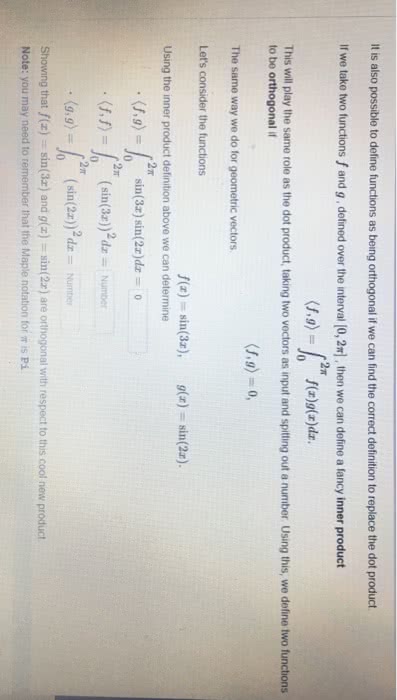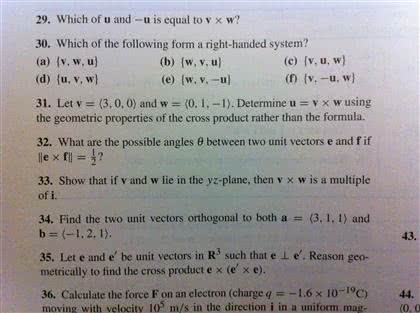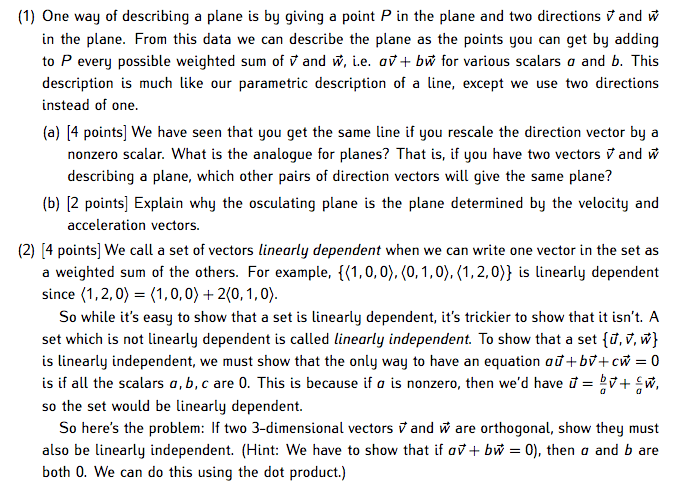MAT 21C Lecture Notes - Lecture 14: Lorentz Force, Cross Product, Parallelogram

MAT 21C – Lecture 14 – Vectors and the Cross Product
• The dot produt ultiplies to etors to gie a salar uer. If e hae
two vectors,
, then
(geometrical definition)
• The algebraic definition of the dot product is
. It
follows that
and
if and only if
and are orthogonal.
• The geometrical definition of the cross product: The normal vector,
has a
direction orthogonal to both
and , (
) where
in that order is a
right-handed system.
• The cross product of two vectors,
, is
. The
magnitude of the cross product is
.
• The angle from
is represented by .
• Example: Standard 3 dimensional unit vectors:
It follows that
Then
. If or
then define
. Vectors
are parallel if and only if
.
• Applications where the cross product arise in physical situations
o 1) Charged particle: A particle has a charge, q and velocity
in a magnetic
field
. Lorentz force =
.
o 2) Meteorology/Weather: The Corolis force =
• Example: Find the area of a parallelogram with sides:
.
The area of the parallelogram,
.
find more resources at oneclass.com
find more resources at oneclass.com

52
MAT 21C Full Course Notes
Verified Note
52 documents
Document Summary
Mat 21c lecture 14 vectors and the cross product: the dot produ(cid:272)t (cid:862)(cid:373)ultiplies(cid:863) t(cid:449)o (cid:448)e(cid:272)tors to gi(cid:448)e a s(cid:272)alar (cid:894)(cid:374)u(cid:373)(cid:271)er(cid:895). If (cid:449)e ha(cid:448)e two vectors, (cid:1873) (cid:1853)(cid:1866)(cid:1856) (cid:1874) , then (cid:1873) (cid:1874) =|(cid:1873) ||(cid:1874) |cos (geometrical definition: the algebraic definition of the dot product is (cid:1873) (cid:1874) = (cid:1873)(cid:2869)(cid:1874)(cid:2869)+(cid:1873)(cid:2870)(cid:1874)(cid:2870)+(cid:1873)(cid:2871)(cid:1874)(cid:2871). The magnitude of the cross product is |(cid:1873) (cid:1876)(cid:1874) |=|(cid:1873) ||(cid:1874) ||sin|: the angle from (cid:1873) (cid:1872)(cid:1867) (cid:1874) is represented by , example: standard 3 dimensional unit vectors: (cid:2835) = ,(cid:2836) = (cid:1853)(cid:1866)(cid:1856) = . It follows that (cid:2835) (cid:1876)(cid:2836) =(cid:1855)| |,|(cid:2835) |=(cid:883),(cid:1853)(cid:1866)(cid:1856) |(cid:2836) |=(cid:883). ; (cid:2836) (cid:1876)(cid:2835) = ; (cid:2836) (cid:1876) =(cid:2835) ; (cid:1853)(cid:1866)(cid:1856) (cid:1876)(cid:2836) = (cid:2835) . If =(cid:882) or (cid:1873) ,(cid:1874) =(cid:882) then define (cid:1873) (cid:1876)(cid:1874) = (cid:882). Vectors (cid:1873) ,(cid:1874) are parallel if and only if (cid:1873) (cid:1876)(cid:1874) =(cid:882): 1) charged particle: a particle has a charge, q and velocity (cid:1873) in a magnetic field (cid:1828) .






